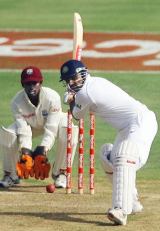Slash and burn
With Virender Sehwag, there is theory and there is practice. The joy of watching him bat lies in the fact that both don't usually overlap.
Siddhartha Vaidyanathan in St Lucia
10-Jun-2006
|
|

|
A couple of days back Virender Sehwag spoke about how he plans to change his approach. "Now, I have reduced my shots," he said, "because in Test matches if you survive the new ball then the session between lunch and tea is comparatively easy ..." Now consider this: he blitzed to his fifty in 33 balls, brought up his hundred in 78, cruised to 150 in 152, and finished with 180 in 190. After violently swishing 17 boundaries in the first session, he shifted gear, cracking just four more in the period between lunch and tea.
With Sehwag, there is theory and there is practice. The joy of watching him bat lies in the fact that both don't usually overlap. When instinct dictates the manner of your approach, factors like pitch texture, bowling potency, and conditions seem marginal. It helped that the team had decided to bat, irrespective of the conditions. The first ball he faced, on a curious surface, where green tufts alternated with brown patches, was slashed for four. Some batsmen like to get set; others just prefer to go.
Sehwag's starts can be menacing, what's even more dangerous is his ability to consistently make the big one - this was his eighth 150-plus score in Test cricket in just his 47th Test. To put things in perspective, Sachin Tendulkar, Sunil Gavaskar and Rahul Dravid, who are ahead of him in the list, have all played more than 100. Great batsmen all, but way short with regard to frequency of big scores.
It wasn't the bowlers who hampered Sehwag, it was the slow outfield. Several crunched drives, which would have run away for four in most venues, resulted in only two and forced Sehwag to resort to savage methods. In the fourth over, after having to settle for successive twos, he drilled Pedro Collins straight down the ground before back-cutting him to the third-man fence off the very next ball.
By the 10th over, he's succeeded in spreading the field; by the 12th he had torn Dwayne Bravo to shreds, overcoming the outfield hassles by lofting over it. When a captain pushes mid-off and mid-on slightly back, ordinary batsmen would look to pinch a single. Sehwag, as he revealed at the end of the day, wanted to hit over them.
Not till the third ball of the 11th over did he play a miss, that too only because he was trying to cutely glide the ball to third man. By the 15th over, he had reached 75 off 47. He'd given himself room outside off and smashed, he'd walked down the ground and smashed. He'd even improvised with his bat angles. If this was a boxing match, the referee would have stopped it then and there. Shock and awe doesn't come much better.
Sehwag was within striking range of a number of records - at a certain point he even had Viv Richards' fastest century in sights - but the only one he was aware of was that no Indian had made a century before lunch in a Test. In the last ball before lunch, he tried to bring it up with a slap past mid-off, scampered the single but failed to notice the possible extra run he could have got off the overthrow. "If I had turned in the last ball before lunch, it could have been possible," he said. "Wasim called me but I had given up. There was no time to turn back."
The next 80 came in 112 balls, by no means slow but relatively snail-paced. "My work till lunch had been completed," he explained. "If I had batted till or after tea, we could build up the score. Also, the field got a bit more spread out - there was deep point, long-off and long-on so opportunities weren't there for boundaries."
Sehwag's worries have been more related to the prolonged periods of drought between two big knocks. In his previous 11 innings, he managed only one half century. The knock before that, he unleashed 254 against Paksitan at Lahore. Maybe it was a problem with the mindset. Maybe, the time he spent with Rudi Webster, the Grenada-based psychologist, could be the turning point. "I had a two-and-a-half hour chat with Rudi and it's helped me a lot," he said of the interaction. "He refreshed my mind and I told him whatever I had in my heart. He suggested that I could do a small routine before or after the ball. While playing continuously, you forget a few routines that you do before facing a ball or before a match. He said, you have done all this earlier, just remind yourself of it."
Siddhartha Vaidyanathan is staff writer of Cricinfo